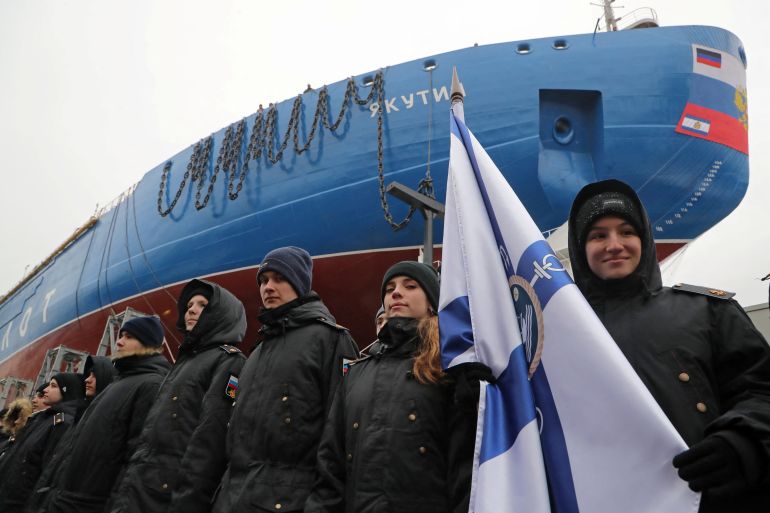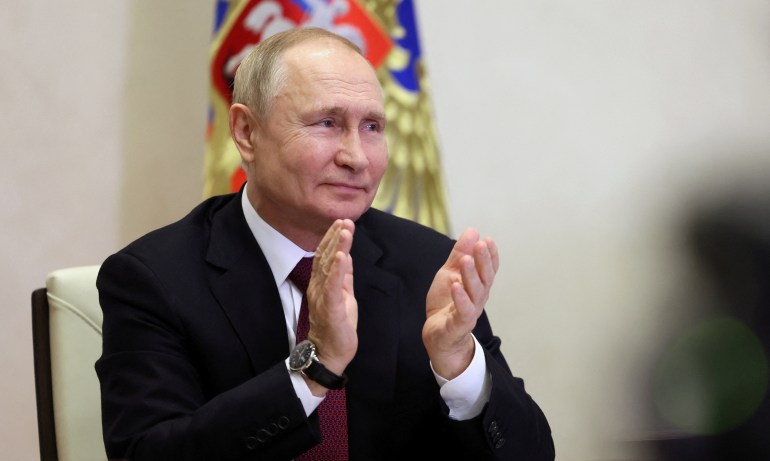Putin touts Russia’s ‘Arctic power’ with new nuclear icebreaker
President vows to develop his country’s nuclear fleet despite current difficulties in Russia’s economy and production.

President Vladimir Putin on Tuesday touted Russia’s Arctic power at a flag-raising ceremony and dock launch for two nuclear-powered icebreakers that will ensure year-round navigation in the Western Arctic.
Presiding via video link from the Kremlin at the launch ceremony in St Petersburg in northern Russia, Putin said such icebreakers were of strategic importance for the country.
Keep reading
list of 4 itemsPutin, Raisi discuss deepening ties between Russia and Iran
Anti-Western and hyper macho, Putin’s appeal in Southeast Asia
Is Ukraine war speeding Europe’s transition to renewable energy?
“Both icebreakers were laid down as part of a large serial project and are part of our large-scale, systematic work to re-equip and replenish the domestic icebreaker fleet, to strengthen Russia’s status as a great Arctic power,” Putin said.
The Arctic is taking on greater strategic significance due to climate change, as a shrinking ice cap opens up new sea lanes.
Vast oil and gas resources lie in Russia’s Arctic regions, including a liquefied natural gas plant on the Yamal Peninsula.
The Kremlin chief pledged to develop his country’s nuclear fleet despite current difficulties in Russia’s economy and production, in an apparent reference to Western sanctions over Moscow’s offensive in Ukraine.
“We will increase the capabilities of our nuclear icebreaker fleet,” Putin said.
He said this should be achieved “using domestic equipment and components”.
The Russian leader added that Moscow was “open to cooperation with our partners” and that “despite the current difficulties, we will definitely implement everything we have planned”.
Putin smiled as the Yakutia nuclear icebreaker was launched into the water at the docks and stood as the Russian national anthem graced the raising of the Russian flag on the Ural icebreaker, which will begin work in December.
The 173.3-metre (569 feet) Yakutia, with a displacement of up to 33,540 tonnes, can smash through ice of up to three metres. It will enter service in 2024.

Two other icebreakers in the same series, the Arktika and the Sibir, are already in service, and another, the Chukotka, is scheduled for 2026.
Putin said a super-powerful nuclear 209-metre icebreaker known as “Rossiya”, with a displacement of up to 71,380 tonnes, would be completed by 2027. It will be able to break through ice four metres thick.
“They are needed for the study and development of the Arctic, to ensure safe, sustainable navigation in this region, to increase traffic along the Northern Sea Route,” Putin said.
“The development of this most important transport corridor will allow Russia to more fully unlock its export potential and establish efficient logistics routes, including to Southeast Asia.”
Putin, who came to power in 1999 promising to end the chaos triggered by the collapse of the Soviet Union, has quietly strengthened Russia’s presence in the Arctic, where Russia has more than 24,000km (15,000 miles) of coastline, stretching from the Barents Sea to the Sea of Okhotsk.
Since 2005, Russia has reopened tens of Arctic Soviet-era military bases, modernised its navy, and developed new hypersonic missiles designed to evade US sensors and defences.
Arctic experts have said it would take the West at least 10 years to catch up with Russia’s military in the region, if it chose to do so.